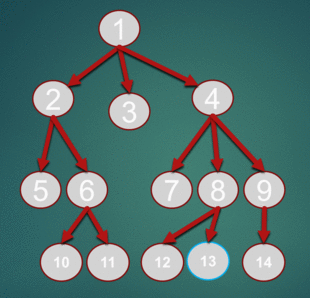For instance, the link structure of a website can be represented by a directed graph, in which the vertices represent web pages and directed edges represent links from one page to another.
What are graph representation?
We have one graph like this:
 |
| Fig. 1. An undirected graph with 5 vertices and 7 edges |
We have 2 ways to represent this graph:
 |
| Fig. 2. The adjacency-list and adjacency-matrix representations |
What 's about directed graphs?
 |
| Fig. 3. A directed graph G with 6 vertices and 8 edges (left), An adjacency-list representation of G (center) and The adjacency-matrix representation of G (right) |
Conception
We set a graph G = (V, E).
- The adjacency-list representation of G:
+ Consists of |V| arrays Adj, one for each vertex in V.
+ For each edge u, the adjacency list Adj[u] contains all the vertices v which is adjacent to u (exists an edge (u, v))
+ The sum of the lengths of all the adjacency lists is:
. |E| if G is a directed graph,
. 2|E| if G is a undirected graph.
- The adjacency-matrix representation of G:
+ Consists of a |V| x |V| matrix A = (a_ij):
a_ij = . 1 if (i, j) in E
. 0 otherwise+ Symmetric matrix: A = A^T
Advantage and Disadvantage
| Adjacency-list representation | Adjacency-matrix representation | |
|---|---|---|
| Advantage | - Using memory in proportion to the number edges => save a lot of memory if the adjacency matrix is sparse - It is fast to iterate over all edges |
- The presentation is simpler, especially when graphs are reasonably small. - Quick to determine whether a given edge (u, v) is present in the graph. - Using only 1 bit per entry for unweighted graphs. |
| Disadvantage | - Slow to determine whether a given edge (u, v) is present in the graph. | - Using more memory - Slow to iterate over all edges |
What are these representations used for?
- Adjacency-list representation: sparse graphs (|E| << |V|^2 )
- Adjacency-matrix representation: dense graphs (|E| ~ |V|^2)There are 2 elementary graph algorithms as below. These algorithms is used for searching, identifying graph data structures.
Breadth-first search
What are applications of BFS?
- Find the shortest path from a vertex s to a vertex v in an unweighted graph.
- Find the length of such a path.
- Find out if a graph contains cycles.
- Construct a BFS tree/forest from a graph.
Pseudocode
Input: A graph Graph and a starting vertex root of Graph.Output: All vertices reachable from root labeled as explored.
Breadth-First-Search(Graph, root):
for each node n in Graph:
n.distance = INFINITY
n.parent = NIL
create empty queue Q
root.distance = 0
Q.enqueue(root)
while Q is not empty:
current = Q.dequeue()
for each node n that is adjacent to current:
if n.distance == INFINITY:
n.distance = current.distance + 1
n.parent = current
Q.enqueue(n)
This is an simulation of BFS with source node: 1, want to find node 13:

Implementation
??Depth-first search
What are applications of BFS?Pseudocode
Implementation
Finding Connected Components (Undirected Graph)
???- Flood Fill - Labeling/Coloring the Connected Components
- Topological sort (Directed Acyclic Graph)
- Bipartite Graph Check
- Graph Edges Property Check via DFS Spanning Tree
- Finding Articulation Points and Bridges (Undirected Graph)
- Finding Strongly Connected Components (Directed Graph)
No comments:
Post a Comment